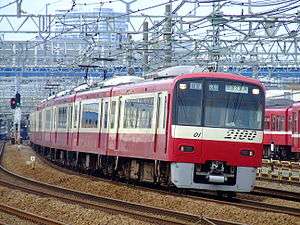Keikyu 2100 series
| Keikyu 2100 series | |
|---|---|
|
Set 2101, July 2007 | |
| In service | 28 March 1998 - Present |
| Manufacturer | Kawasaki Heavy Industries (Kobe) and Tokyu Car (Yokohama) |
| Replaced | Keikyu 2000 series |
| Refurbishment | 2013– |
| Number built | 80 vehicles (10 sets) |
| Formation | 8 cars per trainset |
| Capacity | 942 passengers |
| Operator(s) | Keikyu |
| Specifications | |
| Car body construction | Aluminium |
| Car length |
18,000 mm (59 ft 1 in) (intermediate cars) 18,170 mm (59 ft 7 in) (end cars |
| Width | 2,830 mm (9 ft 3 in) |
| Maximum speed | 120 km/h (75 mph) |
| Traction system |
Original: GTO-VVVF (Siemens) Current: IGBT-VVVF (Toyo Denki) |
| Acceleration | 3.5 km/h/s |
| Deceleration |
4.0 km/h/s (service) (4.5 km/h/s emergency) |
| Electric system(s) | 1,500 V DC overhead line |
| Track gauge | 1,435 mm (4 ft 8 1⁄2 in) |
The Keikyu 2100 series (京急2100形) is a DC electric multiple unit (EMU) train type operated by the private railway operator Keikyu in the Tokyo area of Japan since 1998. It replaced the earlier 2000 series on limited-stop Limited Express (快特 Kaitoku) services.[1] A total of 10 8-car sets were built by Kawasaki Heavy Industries,[2] and Tokyu Car,[3] and the first sets entered service on 28 March 1998.
Electrical systems
Its original GTO-VVVF propulsion system was supplied by Siemens.[4] The ability to produce a "fa-so-la-ti-do-re-mi-fa-so" scale when the propulsion starts up quickly became a signature to the 2100 series when it was introduced, earning the nickname as the "singing train" (歌う電車).[5] Subsequently, similar propulsion was also installed on 56 cars of the N1000 series. The uniqueness of the propulsion system made its way into various music and popular culture, such as Super Bell"Z. Due to the unavailability of substitute parts for the train's GTO-VVVF propulsion system,[5] the propulsion system on every train was replaced with a new IGBT-VVVF propulsion system (supplied by Toyo Denki) that does not have a solfège scale.
Formation
As of 1 April 2012, ten 8-car sets were in operation, formed as follows, with four motored (M) cars and four trailer (T) cars, and car 1 at the Misakiguchi end.[6]
| Car No. | 1 | 2 | 3 | 4 | 5 | 6 | 7 | 8 |
|---|---|---|---|---|---|---|---|---|
| Designation | Muc | T | Tp | Mu | Ms | T | Tp | Msc |
| Numbering | 21xx | 21xx | 21xx | 21xx | 21xx | 21xx | 21xx | 21xx |
The two "Tp" cars are each fitted with two single-arm pantographs.[6]
Interior
Passenger accommodation consists of transverse seating arranged 2+2 abreast, with seat backs that can be flipped over to face the direction of travel. The windows on the 2100 series are double-glazed, with curtains.
 Interior view
Interior view
Refurbishment
Set 2101 was the first 2100 series set to undergo refurbishment, in 2013. Modifications include replacing the passenger windows at the ends of each car with opening windows, replacing the curtains on these windows with roller blinds, and replacing the original fluorescent tube lighting with LED lighting.[7]
By March 2015, all of the original Siemens-powered GTO-VVVF traction motors were replaced with new IGBT-VVVF traction motors manufactured by Toyo Denki.[8]
Livery variations
Trainset 2157 carried a "Keikyu Blue Sky Train" livery, and used on airport services from 11 June 2005. From March 2015, set 2133 received the "Keikyu Blue Sky Train" livery.[8] From 21 February 2016, set 2133 operated in a modified version of its blue livery, adapted to resemble the livery of Taiwan Railways Administration trains, to mark the first anniversary of the signing of a friendship agreement between Keikyu and Taiwan Railways Administration.[9]
 Set 2157 in "Keikyu Blue Sky Train" livery in October 2006
Set 2157 in "Keikyu Blue Sky Train" livery in October 2006 Set 2133 in "Keikyu Blue Sky Train" livery modified to resemble Taiwan Railways livery in May 2016
Set 2133 in "Keikyu Blue Sky Train" livery modified to resemble Taiwan Railways livery in May 2016
References
- ↑ 私鉄車両年鑑2012 [Japan Private Railways Annual 2012]. Tokyo, Japan: Ikaros Publications Ltd. February 2012. p. 126. ISBN 978-4-86320-549-9.
- ↑ 京浜急行電鉄2100形電車 概要, Kawasaki Heavy Industries, retrieved 30 June 2008
- ↑ 京浜急行電鉄 2100形, Tokyu Car, retrieved 30 June 2008
- ↑ Metro System, Eight-Car Units, Keihin Kyuko, Tokyo, Japan, Siemens AG, retrieved 30 June 2008
- 1 2 "「歌う電車」消えゆく運命 京急の136両、交代へ" (Singing trains might disappear - change due for 136 Keikyu cars), Asahi Shimbun, 4 June 2008. Retrieved on 27 October 2008. (Japanese)
- 1 2 私鉄車両編成表 2012 [Private Railway Rolling Stock Formations - 2012]. Japan: Kotsu Shimbunsha. July 2012. p. 42. ISBN 978-4-330-29911-2.
- ↑ 京浜急行電鉄2100形車体・機器更新車 [Keikyu 2100 series refurbished set]. Japan Railfan Magazine (in Japanese). Vol. 53 no. 631. Japan: Koyusha Co., Ltd. November 2013. p. 53.
- 1 2 京急2100形2133編成が「KEIKYU BLUE SKY TRAIN」となり出場 [Keikyu 2100 series set 21343 outshopped in "Keikyu Blue Sky Train" livery]. Japan Railfan Magazine Online (in Japanese). Japan: Koyusha Co., Ltd. 11 March 2015. Retrieved 11 March 2015.
- ↑ 京急 台湾鉄路管理局のラッピング列車 運転開始 [Keikyu starts running train in Taiwan Railways Administration livery]. RM News (in Japanese). Japan: Neko Publishing Co., Ltd. 22 February 2016. Retrieved 22 February 2016.
External links
| Wikimedia Commons has media related to Keikyu 2100 series. |
- Keikyu 2100 series official information (Japanese)

